The island was originally populated by indigenous aboriginal Taínos. However all that changed when Christopher Columbus presumptuously decided the place should belong to Spain, in 1493.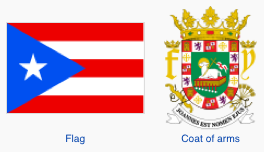 The island was then forcibly colonized and the Taínos were coerced into slavery and nearly exterminated by weapons and Euro-diseases. In 1520 King Charles I ended slavery and Spain possessed Puerto Rico for more than 400 years during which immigrants from all over Europe moved to the islands. There are actually several islands under the name of Puerto Rico including Vieques, Culebra, and Mona.
The island was then forcibly colonized and the Taínos were coerced into slavery and nearly exterminated by weapons and Euro-diseases. In 1520 King Charles I ended slavery and Spain possessed Puerto Rico for more than 400 years during which immigrants from all over Europe moved to the islands. There are actually several islands under the name of Puerto Rico including Vieques, Culebra, and Mona.
Under the Treaty of Paris of 1898, Spain ceded the island to the United States after the Spanish-American War. Puerto Ricans became U.S. citizens in 1917, and today the United States Congress governs many aspects of Puerto Rican political life. The island’s current status, including the possibility of statehood or independence, is widely debated in Puerto Rico.
Laws versus Attitudes
Gay marriage exists in Puerto Rico due to Federal Court rulings that the 2015 US Supreme Court decision also applies to Puerto Rico. Even before the ruling there awere thousands of LGBT couples living as domestic partners without interference from authorities or, for the most part, from neighbors or families.
Puerto Rican civil rights laws to forbid discrimination on the basis of sexual orientation in the areas of employment, public transportation and public facilities, business transactions and housing. Despite such laws, a research study found that 82% of those interviewed felt some kind of prejudice against LGBT people in Puerto Rico; 17% felt no prejudice or were indifferent to gays. A CNN poll on the mainland USA revealed that 55% of those questioned support gay marriage. The poll did not include Puerto Rico but is offered here as a sign that attitudes in the Americas toward LGBT people are shifting toward fairness. Mexico City allows gay marriage; Colombia was the first South American nation to officially recognize gay unions and Argentina now allows full gay marriage. In Brazil, a LGBT couple may convert their civil union into marriage with the approval of a state judge. In Ecuador civil union couples are legally recognized as a family and share all the same rights of married heterosexual couples.
When this writer visited San Juan several years ago I was introduced to dancers from the Ballet de San Juan company, which is a serious and skilled dance company. Not surprisingly, there were a number of LGBT dancers and staff members involved with the company. Several of the older teachers were coupled for many years and some of the younger ones for several months. Most of the company were non-gay but had no reservation about anyone’s orientation. They were a bubbly hard-working troupe and presented a fine production of Swan Lake that year. (One of them was a svelte young dancer, David Cuevas, whom I met and interviewed. He later went on to perform with the American Ballet Theatre in New York; tragically he died at the age of 33 from AIDS.
Styles of Homosexual Behavior
Regardless of cultural or racial affiliations, LGBT natives are naturally everywhere in the Caribbean. Their particular personal situations vary widely according to their family, religious and political circumstances, as well as the level of homophobia in their culture. The most public type is  a person who feels unashamed and identifies as gay and desires intimate contact only with others of the same gender. These people form the core of the modern gay-rights movement. Most of these people are out and accepted by their friends and family although a few are harassed, bullied and occasionally injured. Some others are quietly known and are left alone. Those with strong self-confidence are amused and talk back to their offenders but, sadly and commonly, many LGBT people fear coming out and are urged to marry and have kids in order to fit in with family and religious expectations to avoid suspicion. (photo right singer Ricky Martin).
a person who feels unashamed and identifies as gay and desires intimate contact only with others of the same gender. These people form the core of the modern gay-rights movement. Most of these people are out and accepted by their friends and family although a few are harassed, bullied and occasionally injured. Some others are quietly known and are left alone. Those with strong self-confidence are amused and talk back to their offenders but, sadly and commonly, many LGBT people fear coming out and are urged to marry and have kids in order to fit in with family and religious expectations to avoid suspicion. (photo right singer Ricky Martin).
Homo Types
This leads to the reality that in Puerto Rico there are various degrees of sexual behavior; closeted gays married to women are engaged in bisexuality. Bisexuality also varies according to circumstances such as straight people living in institutions like schools, prisons or military troops where same-sex contact is more occasional and less commital.
Another active population is found in the sex-trade, or ‘industry’. These are gay and straight ‘workers’ that populate the world over. Some of these are captive sex-slaves (mostly heterosexual females) abducted or sold from their (foreign) homes and forced into the trade. Many others are not slaves but are attracted by the money from paying clients especially tourists. These ladies and laddies of the night are regularly seen on street corners or hustling in bars, usually dressed suggestively.
There is much documentation of sex tourism in the Caribbean which plays on the stereotype of the genitally well-endowed Afro-Caribbean male who is ever-present and looking to satisfy the ‘lonely’ ladies and gents who go on holiday in quest of sunshine and pleasure. “On certain street corners throughout the islands, West Indian males strike a familiar pose with one hand resting authoritatively on the crotch, with an occasional squeeze. Sometimes this is simply a reassuring habit, a reminder that the bamboo is ready for action”. Often a male poseur (rent-boy or gay-for-pay or taxi boy) will be more assertive and inviting toward his targeted visitor, certainly more overt than the usual ‘look’ often associated with casual cruising.
It should be added, however, that erotic fantasies often translate into less than fun times: in a recent study, “some women did not have a satisfying sex experience. Said one, the average West Indian man’s “understanding of good sex is restricted to painful banging”. As well, women of the Caribbean are speaking more openly now of their partners’ insensitivity and ignorance.” So, a good endowment does not ensure good quality.
Down-Low and Online
A variant of Caribbean sexuality can be read on a new online website called Discreet City, “the first online magazine created by and for Masculine Gay/Bisexual Men of Color.”One of their dozen-plus categories of information (politics, advice, health, social & travel, etc.) is Sex & Dating that includes talk about being on the ‘down low’, heterosexually married men who have sex with other men. (Although undocumented, some women also engage with other women.)
 Once a deep secret in the closet and underground, in recent years this has become widely known in the ‘colored’ gay and straight communities. For ‘down-low’ men in the homophobic Afro-Caribbean population in Puerto Rico it is a way of life for survival’s sake as well as a way to find authentic or momentary pleasure intimacy while avoiding exposure and public shame. These folks are virtually invisible and very private. No one reveals himself willingly; it’s secretive and plays on the edge of duplicity, deception and betrayal. It is an emotionally stressful consequence of the disease of homophobia.
Once a deep secret in the closet and underground, in recent years this has become widely known in the ‘colored’ gay and straight communities. For ‘down-low’ men in the homophobic Afro-Caribbean population in Puerto Rico it is a way of life for survival’s sake as well as a way to find authentic or momentary pleasure intimacy while avoiding exposure and public shame. These folks are virtually invisible and very private. No one reveals himself willingly; it’s secretive and plays on the edge of duplicity, deception and betrayal. It is an emotionally stressful consequence of the disease of homophobia.
Not even a gay (or lesbian) tourist who happens to trick with a ‘down-low’ husband (or wife) is likely to know the truth about his or her Mr/Ms Right-Now. Significant forces help create this down-low life behavior: religion, machismo, and strong family/nationalistic ties. The Puerto Rican population is 95% Catholic. The Church is strong with a fundamental Christian base that preaches against the ‘sin’ of homosexuality–indeed any sex outside of marriage.
Living discreetly helps avoid any family shame or dishonor. “It appears that any expression of sexuality outside matriarchal heterosexuality is uniformly unwelcome,” wrote one researcher. “We grow up in very close-knit families with the mother as the anchor of the matriarchal hierarchy. Men wear the pants but women are the ones we fear.
Less visible but equally powerful is the inherited African ethos of male machismo that infuses an individual’s masculine development starting in childhood. (See this sad report: children prefer machismo over education.) It seems women are not acknowledged when it comes to homosexuality in the Afro-Caribbean culture, which leads to both a certain feminine freedom as well as ignorance about same-sex intimacy.
By tradition, a young adult is not supposed to leave their parents’ home until married or go to University. So most of these people live at home and never have a place to date (both homosexual and heterosexual). “That is why cars and public spaces in Latin cultures are so busy,” laughed one discontent ex-pat in Florida.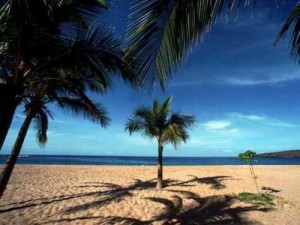
This man’s life in PR was not happy: “homosexuals in Puerto Rico have not been able to achieve a sense of community. Too afraid to come out of the closet, they do not organize and contribute to eradicate their own problems… Our culture makes them incapable of preventing diseases, mainly because a lot of gay Puerto Ricans can’t admit that they are gay. They get married, have families, but then go on the down low to get homosexual sex: thus exposing wives and relatives to diseases.” (Quoted from Windy City)
Ironically, the long standing tradition of criminalizing homosexual behavior was initiated by the British (now a leader in gay-lib) when many Caribbean islands were forced into becoming colonies of the once-great Empire. As well, the historic prejudice against homosexuality in the African cultures was imported to the Caribbean with slavery in the 18th and 19th centuries until it was outlawed around 1848 by the English.
Gay Scene in Puerto Rico
In contrast to the preceding negative view, the In San Juan and Ponce, appears quite lively with numerous gay and gay-friendly bars and clubs. A quick look on the Internet reveals a colorful nightlife selection with the usual music, dancing, drinking and cruising–similar but smaller than mainland gay life. See visible scenes.
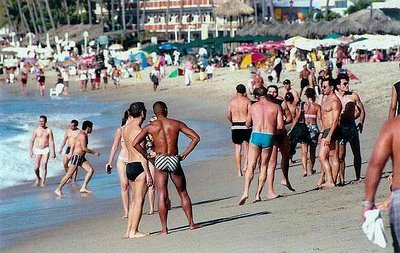 “Many gays in San Juan live in the Condado and Ocean Park areas, the more modern districts east of Old San Juan so the beaches there tend to be more gay-popular and gay-friendly. The most predominately gay beach in Puerto Rico is the stretch of sand fronting the gay Atlantic Beach Hotel at the end of Calle Vendig in Condado. A visitor will see LGBT life more openly displayed—open as in smooching lesbians, chatty twinks, the odd hustler, and tourists in Speedos especially during winter high season.
“Many gays in San Juan live in the Condado and Ocean Park areas, the more modern districts east of Old San Juan so the beaches there tend to be more gay-popular and gay-friendly. The most predominately gay beach in Puerto Rico is the stretch of sand fronting the gay Atlantic Beach Hotel at the end of Calle Vendig in Condado. A visitor will see LGBT life more openly displayed—open as in smooching lesbians, chatty twinks, the odd hustler, and tourists in Speedos especially during winter high season.
“Another gay-popular beach area is around the point east of Condado in the upscale residential low-rise Ocean Park area. The somewhat gayish beach there is located between the ends of Calle Taft and Calle Santa Ana streets. This is a better option if you want to feel more like a local. The beaches have been cleaned up in recent years from trash on the sand and seedy characters. It’s openly cruisy at night which can also be risky.” (Quoted from Away.com) In recent years the scene has quietly spread to other areas such as the popular Santurce neighborhood where locals congregate in La Placita (Little Market) on Friday nights.
Gay Pride Fest
is the annual gay pride Festival held in San Juan each Memorial Day weekend. It started a few years ago with a small group of friends as a sort of festive party. The following year the friends invited more friends for the get-together at the same place. The party has jumped from 75 friends and acquaintances to become the crowded annual pride celebration with more than 3,000 local and international participants. It starts in the Condado area and marches to the Parque del Tercer Milenio in old San Juan. It is as colorful as any Pride event on the mainland.
Middle Ground–Activists
Between the two extremes of gay expression–down-low vs bubbly night life and Pride–are LGBT people who choose to live ‘normal’ openly gay lives and are not ashamed or in hiding. Some are activists and want to move LGBT citizens forward to full equality and representation on the political and social scene. Equal rights is not yet an achievement on the island.
Active groups: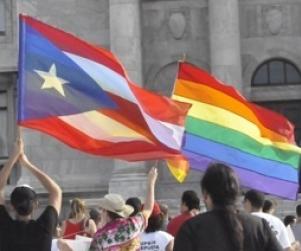
Puerto Rico Para Todos (Puerto Rico for Today) http://www.prparatodos.org/index.html
Ricky Matin Foundation http://rickymartinfoundation.org/es/about/
El Centro de Jovenes (Youth Center); http://www.centrodejovenespr.com/#!colores
Gay San Juan (offers minimal information on the LGBT scene: http://www.gaysanjuan.com/)
Madres Lesbianas (Lesbian Mothers) http://perfiles.universogay.com/
Mujer x Mujer (Woman to Woman) (http://mujerxmujer.com/blog/)
PFLAG Puerto Rico (http://community.pflag.org/)
Other articles about gay Puerto Rico:
Growing up gay in Puerto Rico
Gay San Juan (Passport Magazine)
Gay Ponce (Passport Magazine)
Transsexuals in PR (Passport Magazine)
Also see: https://www.nytimes.com/2015/11/01/opinion/sunday/on-being-queer-in-the-caribbean.html?_r=0
(Photo right from PhotoBucket)
==============
Caribbean Gay-friendly and Gay Unfriendly Islands:
Homosexuality Illegal
In the following eleven countries homosexuality is criminalized:
Antigua and Barbuda,
Barbados,
Barbuda,
Saint Vincent and the Grenadines,
Dominica,
Grenada,
Guyana (on mainland South America), 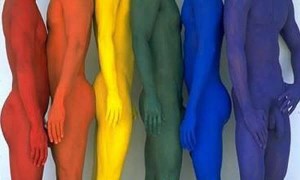
Jamaica,
Saint Kitts and Nevis,
Saint Lucia,
Trinidad and Tobago.
Homosexuality Legal
Fortunately in the Caribbean there are more countries in which same-sex activity is legal. These are:
Bahamas (although with high homophobia),
British Virgin Islands ( Tortola, Virgin Gorda, Jost Van Dyke, Anegada, + others), legal since 2000
Cayman Islands, since 2000
Cuba, since 1979
Dominican Republic,
Montserrat, since 2000
Netherlands Antilles,
Aruba, Bonaire, Curacao (off the Venezuelan coast)
Sint Maarten, Saba, and Sint Eustatius (southeast of the Virgin Islands)
French West Indies (Guadeloupe, since 1791, St Barths, Martinique, since 1791, St Martin)
Haiti, since 1986
Puerto Rico,
Turks and Caicos Islands, since 2000
US Virgins Islands (St. Croix, St. John, St. Thomas, Water Island), since 1984.
















